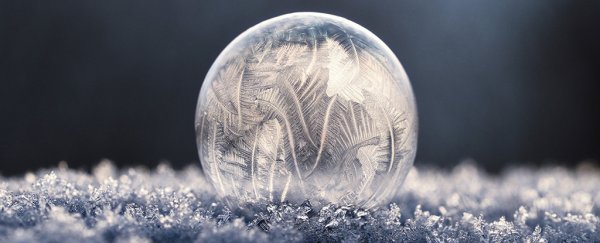Scientists have reached a new low in the cooling of liquid water, hitting -45 degrees Celsius (-49 degrees Fahrenheit). That's way below the usual freezing point, and shows we still have a lot to learn about the physics of this plentiful substance.
In two separate experiments, water was supercooled right down to 230 Kelvin and 227.7 Kelvin, which is -43.15°C (-45.67°F) and -45.45°C (-49.81°F), respectively.
At these kind of extreme temperatures, it's almost as if water becomes two different types of liquid, the scientists say – fluctuating between two different states in the same way that we might deliberate over a decision.
We already know that water can stay as a liquid below zero degrees Celsius (32°F) in certain situations, such as clouds high up in the atmosphere. In fact, the freezing effect is dependent on a number of factors affecting the molecules inside water and how quickly they crystallise.
Scientists have previously been able to delay this freezing, which happens when an initial crystal nucleus forms and begins attracting other molecules, but so far no one's sure just how cold we can get water and still keep its molecules flowing.
"The new remarkable property is that we find that water can exist as two different liquids at low temperatures where ice crystallisation is slow," says one of the researchers, Anders Nilsson from Stockholm University in Sweden.
Nilsson and his colleagues were the ones to hit 227.7 Kelvin, using microscopic droplets of water propelled into a vacuum (the smaller the droplet, the easier it is to keep from freezing). Using advanced X-ray scans, they noticed water of two different densities coexisting together.
The researchers saw "how a glassy state of water transforms into a viscous liquid which almost immediately transforms to a different, even more viscous liquid of much lower density," says one of the team, Katrin Amann-Winkel from Stockholm University.
This coexistence of two densities at a certain super-cool temperature has in fact been predicted before, but this is the first evidence we've seen of it actually being real – evidence that could inform many different areas of research, from food preservation to cryogenics (you wouldn't want your body icing up on a deep space trip, after all).
The second experiment, run by a different international team of researchers, again used microscopic droplets of water inside a vacuum. This time the study demonstrated how the extremely low pressure levels produced evaporation cooling that outpaced the crystallisation process.
That led to the ultra-low cooling point of 230 Kelvin before freezing began to take place. Special laser techniques were required, measuring the size of droplets to gauge their temperature, and this same approach could be used again to study super-cooled water in the future, the researchers say.
"The easiest way to determine the temperature of a spherical droplet was to measure its size, which can be accurately determined by exploiting the presence of an interference pattern in the light scattered by the droplet," senior author, Robert Grisenti from the University of Frankfurt in Germany, told Sam Jarman at Physics World.
Eventually, the technique could even be adapted to measure droplets in the Earth's atmosphere, and improve our understanding of the planet's changing climate.
This is the first time we've been able to observe liquid water at such a low temperature, which means there's still some debate over how accurate these readings are and whether we can push them any further.
What everyone seems to agree on is that these are important areas of research for understanding more about the properties of water, which is key to the health of our planet and life itself.
And we now have a new perspective on it. As one of the researchers from the first experiment, Lars G.M. Pettersson from Stockholm University puts it: "In a nutshell: Water is not a complicated liquid, but two simple liquids with a complicated relationship."
The research has been published in Science and Physical Review Letters.
